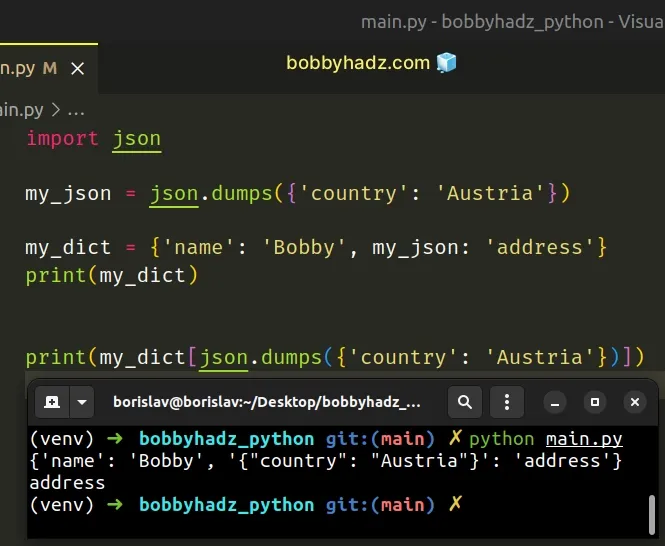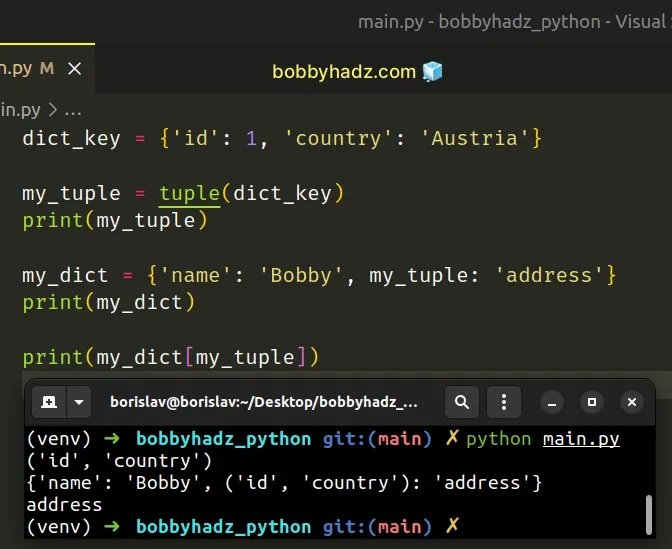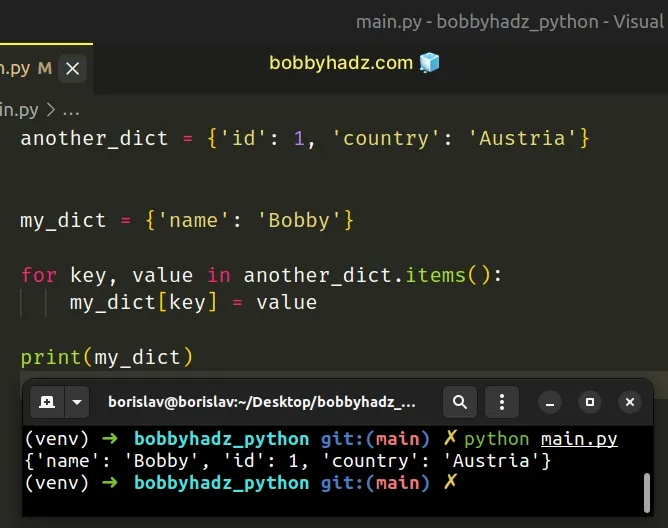TypeError: unhashable type: 'dict' in Python [Solved]
Last updated: Apr 8, 2024
Reading time·5 min

# TypeError: unhashable type: 'dict' in Python [Solved]
The Python "TypeError: unhashable type: 'dict'" occurs when we use a
dictionary as a key in another dictionary or as an element in a set.
To solve the error, use a frozenset instead, or convert the dictionary into a JSON string before using it as a key.

The error occurs when you use a dictionary as a key in another dictionary.
# 👇️ Using a dictionary as a key in a dictionary # ⛔️ TypeError: unhashable type: 'dict' my_dict = {'name': 'Bobby', {'country': 'Austria'}: 'address'}
Or when you use a dictionary as an element in a set object.
# 👇️ Using a dictionary as an element in a set # ⛔️ TypeError: unhashable type: 'dict' my_set = {{'name': 'Bobby'}}
set because dict objects are mutable and unhashable.# Convert the dictionary to a JSON string to solve the error
One way to solve the error is to convert the dictionary to a JSON string before using it as a key.
import json # 👇️ Convert the dictionary to JSON string my_json = json.dumps({'country': 'Austria'}) my_dict = {'name': 'Bobby', my_json: 'address'} print(my_dict) # 👉️ {'name': 'Bobby', '{"country": "Austria"}': 'address'} # 👇️ when you have to access the key in the dictionary print(my_dict[json.dumps({'country': 'Austria'})]) # 👉️ address

The json.dumps() method converts a Python object to a JSON formatted string. This works because strings are immutable and hashable.
Conversely, the json.loads() method
parses a JSON string into a native Python object, e.g.
my_dict = json.loads(my_json_str).
# Using a frozenset to solve the error
An alternative way to solve the error is to use a frozenset.
my_key = {'country': 'Austria'} key = frozenset(my_key.items()) print(key) # 👉️ frozenset({('country', 'Austria')}) my_dict = {'name': 'Bobby', key: 'address'} # 👇️ When you have to access the key print(my_dict[frozenset(my_key.items())]) # 👉️ 'address'

The dict.items() method returns a new view of the dictionary's items ((key, value) pairs).
# 👇️ dict_items([('name', 'bobby'), ('age', 30)]) print({'name': 'bobby', 'age': 30}.items())
We used the dictionary's items to create a frozenset that we can use as a key
in a dictionary (and an element in another set).
frozenset is an immutable version of the Python set object, so it can be used as a key in a dictionary or an element in another set.Notice that you have to use the same approach to access the key in the dictionary.
You can store the result of calling frozenset(my_key.items()) in a variable
and reuse the frozenset when setting or accessing the key in the dictionary.
# Converting the dictionary to a tuple to solve the error
Another way to solve the error is to convert the dictionary to a tuple.
dict_key = {'id': 1, 'country': 'Austria'} # ✅ Convert to tuple my_tuple = tuple(dict_key) print(my_tuple) # 👉️ ('id', 'country') my_dict = {'name': 'Bobby', my_tuple: 'address'} print(my_dict) # 👉️ {'name': 'Bobby', ('id', 'country'): 'address'} # 👇️ When you have to access the key in the dictionary print(my_dict[my_tuple]) # 👉️ address

When you convert a dictionary to a tuple, the tuple only contains the keys of the dictionary.
Tuples are immutable, so a tuple containing a dictionary's keys can safely be used as a key in another dictionary.
# Using one dictionary as a value in another dictionary
You can't use a dictionary as a key in another dictionary, but you can use one as a value.
dict_value = {'id': 1, 'country': 'Austria'} my_dict = {'name': 'Bobby', 'data': dict_value} # 👇️ {'name': 'Bobby', 'data': {'id': 1, 'country': 'Austria'}} print(my_dict) print(my_dict['data']) # 👉️ {'id': 1, 'country': 'Austria'}

We set one dictionary as a value in another dictionary.
This is allowed as the restrictions don't apply to dictionary values.
# Adding all of the key-value pairs of one dictionary to another
You can use a for loop if you need to add all of the key-value pairs of one dictionary to another.
another_dict = {'id': 1, 'country': 'Austria'} my_dict = {'name': 'Bobby'} for key, value in another_dict.items(): my_dict[key] = value # 👇️ {'name': 'Bobby', 'id': 1, 'country': 'Austria'} print(my_dict)

The dict.items method returns a new view of the dictionary's items ((key, value) pairs).
my_dict = {'id': 1, 'name': 'BobbyHadz'} # 👇️ dict_items([('id', 1), ('name', 'BobbyHadz')]) print(my_dict.items())
On each iteration, we set the key-value pair to the other dictionary.
# Hashable vs Unhashable objects in Python
Most of the immutable built-in objects in Python are hashable, whereas mutable objects are unhashable.
set, because these data structures use the hash value internally.Hashable objects include - str,
int, bool, tuple,
frozenset.
Unhashable objects include - list, dict, set.
Note that tuples and frozensets are only hashable if their elements are
hashable.
# Checking if an object is hashable
You can check if an object is hashable by passing it to the built-in hash()
function.
print(hash('bobbyhadz.com')) # 👉️ 4905958875846995527 # ⛔️ TypeError: unhashable type: 'dict' print(hash({'name': 'Bobby Hadz'}))
The hash function returns the hash value of the passed-in object (if it has one).
Hash values are integers and are used to compare dictionary keys during a dictionary lookup.
Objects like dictionaries are mutable because the contents of a dict can be
changed.
my_dict = {'name': 'Alice'} my_dict['name'] = 'Bobby Hadz' print(my_dict) # 👉️ {'name': 'Bobby Hadz'}
On the other hand, fronzenset and tuple objects that contain primitive
values are immutable (and hashable).
Dictionaries are indexed by keys and the keys in a dictionary can be any immutable type, e.g. strings or numbers.
If a frozenset or a tuple contains mutable objects such as lists, it cannot be
used as a key in a dictionary or an element in a set.
If you aren't sure what type of object a variable stores, use the type()
class.
my_dict = {'name': 'Bobby Hadz'} print(type(my_dict)) # 👉️ <class 'dict'> print(isinstance(my_dict, dict)) # 👉️ True my_str = 'bobbyhadz.com' print(type(my_str)) # 👉️ <class 'str'> print(isinstance(my_str, str)) # 👉️ True
The type class returns the type of an object.
The isinstance() function
returns True if the passed-in object is an instance or a subclass of the
passed in class.
# Additional Resources
You can learn more about the related topics by checking out the following tutorials:
- TypeError: unhashable type: 'set' in Python [Solved]
- TypeError: unhashable type 'slice' in Python [Solved]
- Using dot "." notation to access dictionary keys in Python
- Using a variable to access a dictionary Key in Python
- TypeError: 'dict' object is not callable in Python [Fixed]
- Sum all values in a Dictionary or List of Dicts in Python
- Swap the keys and values in a Dictionary in Python

